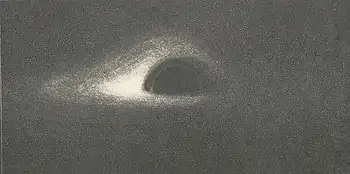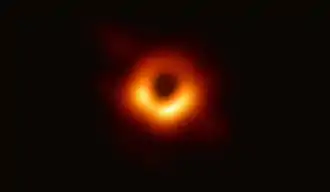Jean-Pierre Luminet
Jean-Pierre Luminet (born 3 June 1951) is a French astrophysicist, writer and poet, world-known specialist of black holes and cosmology. He works as research director for the CNRS (Centre national de la recherche scientifique), and is a member of the Laboratoire d’Astrophysique de Marseille (LAM), of the Laboratoire Univers et Théories (LUTH) of the Paris-Meudon Observatory and a visiting scientist at the Centre de Physique Théorique (CPT) in Marseilles.

He has published many articles in the most prestigious journals and reviews in these areas. He has been awarded several prizes for his work in pure science and in science communication (see Honours and Recognition). He also serves on the editorial board of Inference : The International Review of Science.
The asteroid 5523 Luminet, discovered in 1991 at Mt Palomar Observatory, was named after him.[1]
Indeed, one of Luminet's greatest efforts has been to make his research work understandable to the non-scientific community. Luminet is also a prominent figure in art and literature. He has produced fifteen popular science books, seven historical novels, TV documentaries, multimedia productions, and six collections of poetry. He is also an artist, an engraver, a sculptor and a musician. He has collaborated with celebrated composers such as Gérard Grisey and Hèctor Parra.
Luminet's literary work has been translated into a dozen languages.
Scientific activities
- After studies in Mathematics at Saint-Charles University of Marseilles, in 1976 he moved to Paris-Meudon Observatory to undertake a PhD with Brandon Carter as his advisor. After a few months spent at the Department of Applied Mathematics and Theoretical Physics (D.A.M.T.P) in Cambridge, England, where he met Stephen Hawking, in 1977 he defended his PhD thesis at Paris University on the subject of Singularities in Cosmology. In 1979 he got a permanent research position at the CNRS and developed his scientific activities at Paris Observatory until 2014, before joining the Laboratoire d’Astrophysique de Marseille. In the interval he was a visiting scientist at the University of São Paulo, Brazil (1984 and 1988), at the University of Berkeley, California (1989–1990) and a visiting astronomer at the European Southern Observatory, Chile (2005)

- 1979 – He created the first "image" of a black hole with an accretion disk using nothing but an early computer, much math and India ink, predicting that it could apply to the supermassive massive black hole in the core of the elliptical galaxy M87. In April 2019 the Event Horizon Telescope Consortium provided a confirmation of Luminet's predictions by providing the first telescopic image of the shadow of the M87* black hole and of its accretion disk.
 The first direct image of a black hole, imaged by the Event Horizon Telescope and published in April 2019
The first direct image of a black hole, imaged by the Event Horizon Telescope and published in April 2019 - 1982 – With physicist Brandon Carter, he invented the concept of tidal disruption event (TDE), namely the destruction of a star passing in the vicinity of a supermassive black hole. They showed that this phenomenon could result in the violent destruction of the star in the form of a "stellar pancake", causing a reactivation of nuclear reactions in the core of the star in the stage of its maximum compression. With other collaborators Luminet later developed the model of tidal destruction, predicting specific observational signatures and introducing the concept of “tidal supernovae”. Finally the theory of TDE was confirmed by the observation of spectacular eruptions resulting from the accretion of stellar debris by a massive object located in the heart of Active Galactic Nuclei such as NGC 5128 or NGC 4438, and even explains the superluminous supernova SN 2015L, better known by the code name ASASSN-15lh, interpreted as the tidal explosion of a white dwarf just before being absorbed beneath the horizon of a massive black hole.
- 1995 – With his colleague Marc Lachièze-Rey, he coined the term "Cosmic Topology" for describing the shape of space, proposing a variety of multiply-connected universe models compatible with the standard Friedmann-Lemaître models of relativistic cosmology.
- 2003 – Large scale anomalies in the anisotropies of the cosmic microwave background observed by the WMAP satellite led to the suggestion, by Jean-Pierre Luminet of the Observatoire de Paris and colleagues, that the shape of the universe is a finite dodecahedron, attached to itself by each pair of opposite faces to form a Poincaré homology sphere.[2] During the following years, astronomers searched for more evidence to support this hypothesis but found none.
- Jean-Pierre Luminet is also a specialist in the history of cosmology and in particular the emergence of the concept of the Big Bang, emphasizing in several books and articles the leading role played by the Belgian priest and cosmologist Georges Lemaître. In 2018 the International Astronomical Union (IAU) recommended that the so-called Hubble's law – which relates to the Universe's expansion and underpins modern cosmology – now be known as the Hubble-Lemaître law.
- Now working in Quantum Gravity Theories, Luminet published a critical analysis of the Holographic principle and the AdS/CFT correspondence.
Artistic activities
- In the field of visual arts, Luminet devoted to drawing, engraving (learned with Jean Delpech at Ecole Polytechnique) and sculpture. He exhibited his works in several French and international exhibitions, such as
- 1982 Deux dessinateurs de l'Imaginaire : Gérard Méresse et Jean-Pierre Luminet, Bibliothèque Trocadéro, Paris
- 1994 L'Encre et le Fer, Centre Culturel de Meudon, France
- 1996 Entre art et science, la création, Fondation Dosne-Thiers, Paris
- 2000 Visions de l'espace, Université de Mons-Hainaut, Mons, Belgique
- 2005 L'œuvre au Noir, Collegio Cairoli, Pavia (Italia)
- 2010 Strange Universes, Universitatea Nationale de Arte de Bucarest (Romania)
A thorough analysis of his artwork has been done by Martin Kemp, Professor of Art History at Oxford University.[3][4]
- In the field of literature J.-P. Luminet has published several poetry books and seven novels devoted to the major figures of the history of astronomy.
- In the field of music, Luminet collaborated in 1991 with Gérard Grisey (a former pupil of Messiaen and Dutilleux) to produce a piece of cosmic music called Le Noir de l’Étoile (The Black of the Star). This work for six percussionists, magnetic tape and astronomical signals coming from pulsars has become a classic of contemporary music and is regularly performed around the world.
In 2011 he began a collaboration with Hèctor Parra, who composed the orchestral piece Caressant l’horizon inspired by Luminet's books. In 2017 Luminet wrote the scenario for Parra’s Inscape. Composed for an ensemble of 16 soloists, large orchestra and electronics, the piece describes an Utopian voyage through a giant black hole. It was created in 2018 in Barcelona, Paris and Köln.
- Eventually Luminet likes to establish convergent links between poetry, art, artists and sciences. He has published several artbooks in collaboration with celebrated artists such as Vladimir Skoda, Brigitte Tartière, Marc Pessin or Ernest Pignon-Ernest.
- In 1998 Luminet was a curator of the exhibition Figures du Ciel (Figures in the Heavens), coupled to the opening of the new Bibliothèque nationale de France (October 1998- January 1999)
Television documentaries
J.-P. Luminet was involved in dozens of TV documentaries as a screenwriter or guest participant, including:
- Infiniment courbe, 52 mn, Prod. Arte/CNRS Audiovisuel, 1994. Five international awards
- Vagabondes du Ciel, 52 mn, Prod. Agat Films/Arte 1999, Three international awards
- Du Big Bang au vivant, 90 minutes, ECP Productions (Canada), 2010
- Through the Wormhole with Morgan Freeman, Season 2 Ep.2 "Is there an Edge to the Universe?", 2011
Honours and recognition
Luminet was awarded more than twenty prizes and honours, including:
- In 1997 he won the Flammarion Prize of the Société Astronomique de France
- In 1998 he was elected Correspondig Member of the French Académie de l'Air et de l'Espace
- In 1999 he won the International Georges Lemaître Prize
- In 1999 the asteroid 5523 Luminet was named after him
- In 2000 he was made Knight of the Ordre des Arts et des Lettres (France) and promoted to Officer in 2006
- In 2006 he won the Paul Doisteau-Emile Butet Prize of the French Academy of Sciences
- In 2007 he won the Science Communication Prize given by the European Commission
Selected publications
Popular science books (in French)
- 1987 : Les Trous Noirs (ISBN 2-02-015948-1)
- 1994 : La Physique et l'infini with Marc Lachièze-Rey (ISBN 2-08-035183-4)
- 1998 : Figures du Ciel with Marc Lachièze-Rey (ISBN 2-02-030768-5)
- 1999 : Eclipses, les rendez-vous célestes with Serge Brunier (ISBN 2-04-727256-4)
- 2002 : Le Feu du ciel : météores et astéroïdes tueurs (ISBN 2-7491-0030-5)
- 2004 : L'invention du Big Bang (ISBN 2-02-061148-1)
- 2005 : L'Univers chiffonné (ISBN 2-07-030052-8)
- 2005 : De l'infini with Marc Lachièze-Rey (ISBN 2-10-048674-8)
- 2006 : Le destin de l'univers : Trous noirs et énergie sombre (ISBN 2-213-63081-X)
- 2009 : Bonnes nouvelles des étoiles with Élisa Brune (ISBN 978-2-7381-2287-2)
- 2011 : Illuminations (ISBN 978-2-7381-2562-0)
- 2012 : Astéroïdes : la Terre en danger (ISBN 978-2-7491-1779-9)
- 2015 : L’univers en 100 questions (ISBN 979-1-0210-1654-5)
- 2016 : Dialogues sous le ciel étoilé with H. Reeves (ISBN 978-2221157305)
- 2016 : De l’infini – horizons cosmiques, multivers et vide quantique (augmented edition) with M. Lachièze-Rey, Paris, Dunod
Popular science books (in English)
- 1992 : Black Holes" (revised edition), Cambridge University Press
- 2001 : Glorious Eclipses (with Serge Brunier), Cambridge University Press
- 2001 : Celestial Treasury (with M. Lachièze-Rey), Cambridge University Press
- 2008 : The Wraparound Universe, New York, AK Peters
Novels and poetry (in French)
- 1993 : Noir soleil (ISBN 978-2-86274-275-5)
- 1996 : Les poètes et l'Univers, Éditions le cherche-midi (ISBN 978-2-86274-473-5)
- 1999 : Le Rendez-vous de Vénus (ISBN 978-2-7096-2025-3)
- 2004 : Itinéraire céleste (ISBN 978-2-7491-0263-4)
- 2002 : Le Bâton d'Euclide (ISBN 978-2-253-11471-0)
- 2006 : Les bâtisseurs du ciel, Tome 1, Le secret de Copernic (ISBN 978-2-7096-2596-8)
- 2008 : Les bâtisseurs du ciel, Tome 2, La discorde céleste: Kepler et le trésor de Tycho Brahé (ISBN 978-2-7096-2567-8)
- 2009 : Les bâtisseurs du ciel, Tome 3, L'œil de Galilée (ISBN 978-2-7096-2902-7)
- 2010 : Les bâtisseurs du ciel, Tome 4, La Perruque de Newton (ISBN 978-2-7096-2415-2)
- 2012 : La Nature des choses, Éditions le cherche-midi (ISBN 978-2-7491-2727-9)
- 2014 : Un trou énorme dans le ciel, Éditions Bruno Doucey (ISBN 978-2-362-29058-9)
- 2015 : Ulugh Beg, L'astronome de Samarcande, Éditions Jean-Claude Lattès (ISBN 978-2-253-06787-0)
See also
- Physical Cosmology
- List of cosmologists
- Non-standard cosmology
- Timeline of cosmology
Notes
- "Discovery Circumstances: Numbered Minor Planets (5001)-(10000)". IAU Minor Planet Center.
- Dumé, Belle (8 October 2003). "Is the universe a dodecahedron?". PhysicsWeb. Archived from the original on 2004-10-26.
- Martin Kemp, Luminet's Illuminations, Nature, Nov. 20, 2003, Vol. 426 p.232
- Martin Kemp, Structural Intuitions : Seeing Shapes in Art and Science, University of Virginia Press (2016).
Selected references
- J.-P. Luminet, I mage of a spherical black hole with thin accretion disk, Astronomy and Astrophysics, 75, 228-235 (1979)
- B. Carter & J.-P. Luminet, Pancake detonation of stars by black holes in galactic nuclei, Nature, 296, 212-214 (1982)
- J.-P. Luminet & B. Carter, Dynamics of an Affine Star Model in a Black Hole Tidal Field, Astrophys.J.Suppl. 61, 219-248 (1986)
- M. Lachièze-Rey & J.-P. Luminet, Cosmic topology, Physics Reports, 254, 135-214 (1996)
- J.-P. Luminet et al., Dodecahedral space topology as an explanation for weak wide-angle temperature correlations in the cosmic microwave background, 2003.
- J.-P. Luminet : Interstellar Science, Inference : International Review of Science vol.1 n°2 (March 2015)
- J.-P. Luminet : Cosmic Topology, Scholarpedia, 10(8):31544 (2015)
- J.-P. Luminet : The Holographic Universe, Inference (2)1, (2016)
- J.-P. Luminet : An Illustrated History of Black Hole Imaging : Personal Recollections (1972-2002), (2019)
External links
- Jean-Pierre Luminet Personal page at LUTH
- Luminesciences, the anglophone blog of Jean-Pierre Luminet on Futura-Sciences
- The youtube channel of J.-P. Luminet displaying more than 300 videos of conferences and interviews
- Jean-Pierre Luminet at IMDb
- Bringing Black Holes down to Earth, in European Science Awards 2007
- Getting to know Jean-Pierre Luminet in European Science and Technology, issue 10 (2011)
- Inference : The International Review of Science